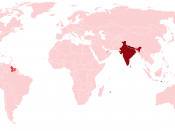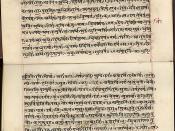Sanatana Dharma, or otherwise known to Western civilization as Hinduism, is one of the world's oldest living religions, dating back to 8000BCE. (Fisher, 2002 p.83). Hinduism has been a religion that has been able to stand fervent against repeated vehement criticism from religious extremist, who have tried to diminish and wipe out Hinduism over the centuries. Perhaps one the reasons Hinduism has been able to stand the test of time and remain as one of the top three religions in the world today is the fact that Hinduism is more of a way of life, rather than a restrained organized religion. The fundamental nature of Hinduism is impregnated in the consciousness of every Hindu and spread throughout every part life of both the Traditionalist and broadminded Hindu.
Sacred Elements that Characterize Hindu Religious TraditionsThe sacred elements that set apart Hindu religious traditions would be difficult to list. The absolute immensity and richness of the Hindu culture and customs handed down from generation to generation have evolved over thousands of years.
Hinduism is not considered a structured religion, but rather an assemblage of hundreds, even thousands of smaller beliefs. Perhaps this is why Hindu beliefs seems so multifarious to Western philosophers. The complexity of Hinduism stems from many deities and gods. The three primary deities of Hinduism are, Shakti, divine feminine, Vishnu, protector of all things, Shiva, creator and destroyer of all living things. (Fisher, 2002 p.103). Hindu deities are portrayed with eight arms, and multiple heads and emblems. These multiple parts are used to set the deities apart from ordinary mortals. Many of the Hindu deities were created over 6000 years ago and are still highly praised in most Hindu cultures today. The Hindu deities' number over 330 million and with the sheer number being so large may indicate that...



Well-written, but some facts stand out as odd
An well written essay, to say the least.
But being a Hindu myself, some facts do stand out as odd. "The three primary deities of Hinduism are, Shakti, divine feminine, Vishnu, protector of all things, Shiva, creator and destroyer of all living things." (second para). Since childhood, I have been told that the primary deities are the Trinity - Brahma, Vishnu and Mahesvara (Shiva).
With respect to "The Hindu deities' number over 330 million", I can say that the number of deities are fairly large, but have never heard of a number so large.
Also, it could be mentioned that there is no initiation ceremony to be considered a Hindu.
0 out of 0 people found this comment useful.